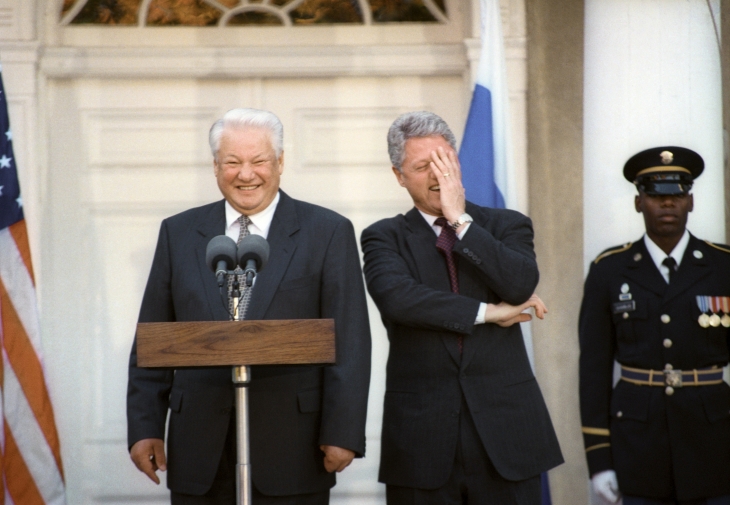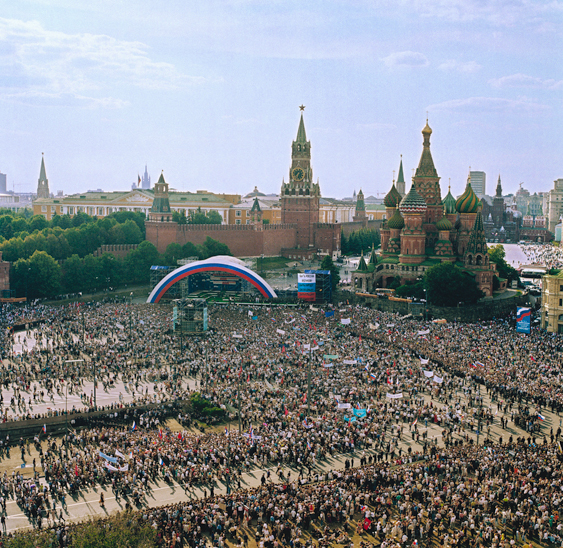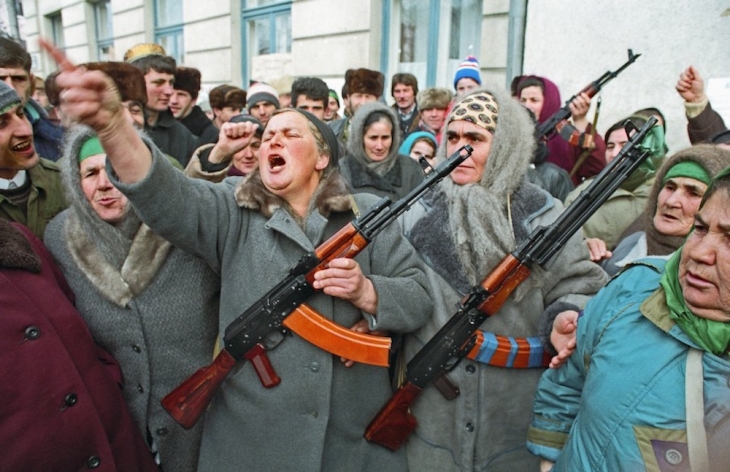Boris Yeltsin and his time



On the 80th anniversary of the first President
The USA. US president Bill Clinton and the President of the Russian Federation Boris Yeltsin during press conference. 1995. ITAR-TASS photo
Meeting-concert in support of Yury Luzhkov and Boris Yeltsin. May 12, 1996. Moscow. On May, 12th, 1996 on Vasilevsky descent meeting-concert in support of Yury Luzhkov and Boris Yeltsin who has collected about 500 thousand Muscovites has taken place ITAR-TASS photo
Participants of meeting lasting many days. Grozny. 1994
Moscow, 27.01.2011—9.03.2011
exhibition is over
Share with friends
For the press
Yeltsin's rule represents one of the most contradictory periods in Russian history. The 90s were inevitable, bringing a breakdown in the system and a changed way of life as images of the Russian leaders disappeared from view. Already the 80s seemed a parody of the 70s. Collapse was not far away. And if not Yeltsin or Gaidar, then sooner or later someone else would have dismantled the old system, transformed the way of life and erased our leaders' faces from the posters. The 90s are faultless in their calendar precision. Not like the 1960s — ragged at the edges, with the Thaw initiated in the 50s and ending with the crackdown in August 1968. A time of transition and bourgeois revolution, the Yeltsin era began in 1990 when Russia acquired formal and informal independence, and ended with the midnight chimes of 31 December 1999 —when the living symbol o the decade announced his resignation. The end of an era whose pictorial spectrum was unbelievably colourful, eclectic and ecstatic. Historical hysteria. Hysterical history. The 1990s began with black-and-white photographs, tore through years stained with the color of blood and ended with a frenzy of alternating colours, one after the other like a child's kaleidoscope. The 1990s put an end to staged shots that only imitated life and history. Citizens of a country falling apart at the seams found themselves caught up in momentous events, in the giant cauldron of history. For a while something depended on them, they became the subject of history rather than the object. Personal considerations were replaced by public politics. The congress tribune was the most important instrument of the epoch. Personal considerations were replaced by public politics. The 90s marked the ten-year tail end of the era of Gorbachev, who probably had no idea where his policies of perestroika and glasnost were going. Nor is it likely that Boris Yeltsin fully understood the results of his actions. But as with any outstanding politician, Yeltsin's almost feral heightened instinct, a sense of history and phenomenal political intuition swayed the rational element in his thinking. And indeed, these qualities intuitively led him to oppose Gorbachev at first, then to iberal reforms, the fiascos of the campaign in Chechnya and finally selection of an heir apparent who would later speak of his heritage from the 1990s in less than complimentary terms. The 90s was an epoch of raised expectations precisely because it was a time of freedom. Everyone thought freedom would automatically bring prosperity and contentment. Although freedom actually meant one thing — we shouldered the responsibility for ourselves and our actions. The state as father figure was no more. Enterprises that kept entire cities afloat crumbled. Gone was the time when decisions were taken for us by the Communist Party, by the personnel distribution commission at your institute of higher education or the food parcel distribution office at your place of employment. Even the sudden abundance of goods on sale involved a choice and responsibility for the choice that people who had lived through the previous epoch were not yet ready to assume: before Gaidar's liberalisation they had fought to stand in ine for sausage that only came in one variety, afterwards there were no queues and twenty new varieties of sausage. We needed to know how to use this new-found freedom to make choices. Without that knowledge we were unable to find the money for even one of the twenty kinds of sausage on offer. In retrospect the 90s seem as colorful as an illustrated news feature, a period when our foundations were rent asunder. We forget that this destruction was constructive. One state system foundered. But a new system appeared amid the ruins. The achievements of the early 21st century were built on the foundations of the 1990s. This transitional decade showed everyone there was no going back. The bridges leading back to socialism were burned after the liberalization of prices, privatisation, the events of October 1993 and the 1996 elections. All that remained were nostalgia pangs for pre-reform days, antipathy towards the 90s yet a sense of their inevitability. We had to live through the 90s. For some this was the worst time of their life and for others the happiest time, which is always the case in periods of revolutions and Freedom. It is almost impossible to single out one individual in these photographs of the decade that mostly record mass movements, mass outbursts, mass pain and mourning. We know about the'Sixties generation'. Was there a 'Nineties generation'? Or were they just the same people — the'Sixties generation', the'Seventies generation', who changed or were obliged to change until they were unrecognisable during those ten years? The 90s were direct successors of the 60s in the spirit of freedom nourishing the end of perestroika, the creation of independent states and a bourgeois, almost bloodless economic revolution. They became a period for rejecting the heritage of 'Sixties' values. A more pragmatic phase of stability set in, when the state, society, simple and not so simple citizens digested the results of the past decade. And the deeds, words, objects, passions and aesthetics of the last 30 years under Soviet rule became obsolete and vanished from collective and individual memory. They became History... Soon after this the 90s, too, became History.
The'Boris Yeltsin and His Time' exhibition presents more than 400 photographs from the Moscow House of Photography Museum archives, the ITAR-TASS agency, RIA Novosti, and also the private archives of photographers: Vladimir Musaelyan, Igor Utkin, Pavel Kassin, Dmitri Sokolov, Alexander Chumichev, Eddy Opp, Igor Mukhin, Sergei Burasovsky and others. Excerpts from television programmes of the Yeltsin era, speeches by Boris Yeltsin himself and films about him will also be shown. All this allows us to trace the evolution of Yeltsin's image during his ten-year term as President of the Russian Federation and also the evolution of the visual image of that period, how the faces and social behavior of each one of us changed. The press will be a ubiquitous element among the exhibits. A free press is one of the main characteristics of the Yeltsin era, an era when the profession'journalist' acquired new significance in the new Russia.










